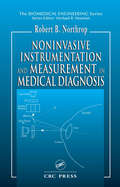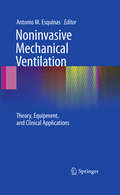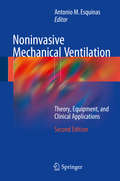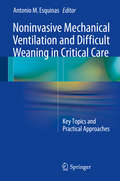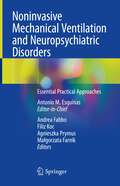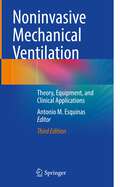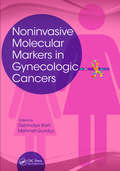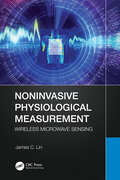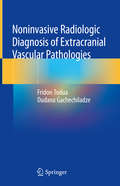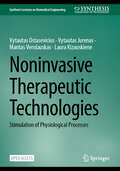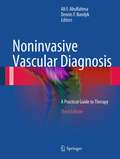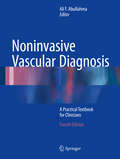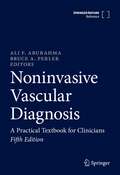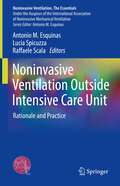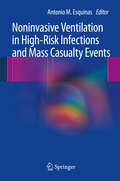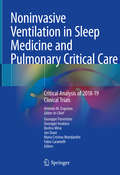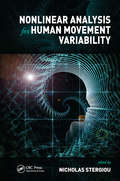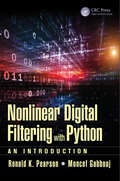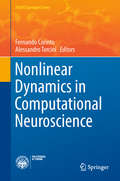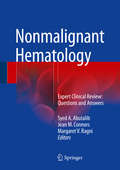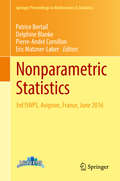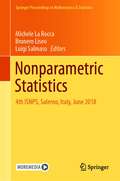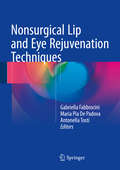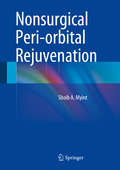- Table View
- List View
Noninvasive Instrumentation and Measurement in Medical Diagnosis
by Robert B. NorthropNoninvasive medical diagnosis (NIMD) is as old as medical practice itself. From the earliest healers' observations of odors, skin color, and breath sounds to today's wealth of technologies, the basics remain the same and keep the role of NIMD essential to effective medical care. Noninvasive Instrumentation and Measurement in Medical Diagnos
Noninvasive Mechanical Ventilation
by Antonio EsquinasNoninvasive mechanical ventilation is an effective technique for the management of patients with acute or chronic respiratory failure. This comprehensive and up-to-date book explores all aspects of the subject. The opening sections are devoted to theory and equipment, with detailed attention to the use of full-face masks or helmets, the range of available ventilators, and patient-ventilator interactions. Clinical applications are then considered in depth in a series of chapters that address the use of noninvasive mechanical ventilation in chronic settings and in critical care, both within and outside of intensive care units. Due attention is also paid to weaning from conventional mechanical ventilation, potential complications, intraoperative applications, and staff training. The closing chapters examine uses of noninvasive mechanical ventilation in neonatal and pediatric care. This book, written by internationally recognized experts, will be an invaluable guide for both clinicians and researchers.
Noninvasive Mechanical Ventilation
by Antonio M. EsquinasThe new edition presents updates regarding new clinical applications of noninvasive mechanical ventilation and discusses recent technical advances in this field. The opening sections are devoted to theory , equipment, with new chapters on clinical applications in emergency medicine, critical care and sleep medicine, with detailed attention to current studies on NIV-CPAP, innovative clinical implications of NIV-CPAP devices. Due attention is also paid to new ventilation modes and the development of synchronization and patient ventilator interaction results. The closing chapters examine clinical indication. Written by internationally recognized experts in the field, this book will be an invaluable guide for both clinicians and researchers.
Noninvasive Mechanical Ventilation and Difficult Weaning in Critical Care
by Antonio M. EsquinasThis book establishes the indications for the use of NIV in the context of weaning from invasive mechanical ventilation. It provides a comprehensive overview of key topics relevant for correct practical application, including NIV and weaning principles, important aspects of patient care before and after weaning, and pediatric and neonatology weaning. Finally, the book summarizes international guidelines and new perspectives of NIV during weaning. With contributions by international experts in the field on noninvasive mechanical ventilation, the book will serve as a valuable guide for critical care physicians, respiratory physiotherapists, and pulmonologists.
Noninvasive Mechanical Ventilation and Neuropsychiatric Disorders: Essential Practical Approaches
by Antonio M. Esquinas Andrea Fabbo Filiz Koc Agnieszka Prymus Małgorzata FarnikIn different sections of this book the relationships between the patterns of psychological response in acute and chronic respiratory failure, as well as the epidemiology of neuropsychiatric disorders in ventilator management, are collected and analyzed. Main concepts such as “vulnerability to stress”, critical illness-psychological stress and susceptibility that may develop during NIV support, as well as the diagnosis of neuropsychiatric disorders in respiratory failure are also summarized. A section is devoted to the most frequent indications of NIV, also including a special use of NIV in pandemic and high-risk infections, as well as in several other conditions such as acute and chronic respiratory failures and neurological disorders. A summary of practical approaches for treatment and prevention in neurologic and psychiatric disorders during noninvasive mechanical ventilation, as well as the perspective in terms of outcomes, quality-of-life, palliative care is also given.The book is intended for all those healthcare professionals treating patients suffering from neurological or psychiatric disorders and who develop acute or chronic respiratory failure. Neurologists, psychiatrists, pulmonary critical care professionals, geriatricians, internists and psychologists will find in the book a valuable guide for their everyday clinical practice.
Noninvasive Mechanical Ventilation in High Risk Infections, Mass Casualty and Pandemics
by Antonio M. EsquinasThe second edition of this book describes the clinical indications of NIV in patients hospitalized with high-risk infections as well as in the prehospital management of mass casualty incidents, including chemical or biological disasters and pandemics. In recent decades, we have learned the impact that different pandemics and mass casualty disasters can outcome in terms of health resource use, health costs and human lives. The development of respiratory failure in these patients, either infectious or non-infectious causes, has led to develop employment plans related both to invasive or noninvasive mechanical ventilation during acute respiratory failure.In this book authors evaluate a rational basis for indications, specific noninvasive mechanical ventilation indications in hospitalized patients (tuberculosis, bacterial, virus, etc.) and prehospital applications (mass casualty: chemical, biological disaster), equipment (ventilators, interfaces) and plan organization for health systems: how and when apply NIV. A critical review of already published studies is described as well as implications and how will be the future according to international expert opinions.Therefore, this updated edition represents a useful scientific reference point according to what it has been experienced in the last pandemics, with respect to the growing role that NIV has and must have in the world.
Noninvasive Mechanical Ventilation: Theory, Equipment, and Clinical Applications
by Antonio M. EsquinasThe 3rd and updated edition of this book represents a new and unique scientific reference for the medical community on how to understand rationale and applications of noninvasive mechanical ventilation (NIMV). Its aim is to establish the indications of NIMV in critically ill patients in weaning from invasive MV. Nowadays, there is a growing evidence-based medicine that recommends use of NIMV in patients after extubation or in difficult weaning patients also affected by comorbidities. This book has been conceived with the vision or providing the best resources for everyone working in ICUs even if belonging to different specialties (intensive care, anesthesiology, pneumology, emergency medicine, etc.). Considering the enormous increase of literature on this topic, authors have selected major key topics related to NIMV, excluding those with low rate of interest, have updated previous topics and have introduced new items collecting them in a practical book analyzing major key topics for a correct practical applications. A new gaze has been devoted to emergency medicine and prehospital applications and technical developments (new ventilation modes: neurology adaptive modes, average support mode and to the development of synchronization and patient-ventilator interaction result). A section dedicated to sleep medicine - due to the new interesting studies on NIV-CPAP adaptation studies, clinical impacts of CPAP devices and ventilatory modes representing an essentials development for a new adequate analysis - is now included. A part devoted to clinical indications based on the observation of new clinical indications in anesthesiology and pneumology in NIV as complementary technique for procedures like bronchoscopy, pre-oxygenation and difficult endotracheal intubations is also now foreseen.
Noninvasive Molecular Markers in Gynecologic Cancers
by Debmalya Barh Mehmet GunduzEarly detection is critical for any given cancer. With the advent of the latest omics technologies, molecular markers in combination with conventional diagnostic and screening methods are emerging as next-generation early diagnostic and prognostic strategies that can allow early-stage diagnosis, resulting in more effective treatment and patient car
Noninvasive Physiological Measurement: Wireless Microwave Sensing
by James C. LinThis book explains the principles and techniques of microwave physiological sensing and introduces fundamental results of the noninvasive sensing of physiological signatures, vital signs, as well as life detection. Specifically, noninvasive microwave techniques for contact, contactless, and remote sensing of circulatory and respiratory movements and physiological volume changes are discussed.Noninvasive Physiological Measurement: Wireless Microwave Sensing, is written by a pioneering researcher in microwave noninvasive physiological sensing and leading global expert in microwaves in biology and medicine. The book reviews current advances in noninvasive cardiopulmonary sensing technology and measurement. It includes measurements of the vital signs and physiological signatures from laboratory and clinical testing. The book discusses the applicable domains and scenarios in which there is an interaction of radio frequency (RF) and microwaves with biological matter in gas, fluid, or solid form, both from inside and outside of the human or animal body. The book also provides examples for healthcare monitoring and diagnostic applications through wearables, devices, or remote contactless sensors for physiological signals and signature, vital signs, and body motion sensing. This book is an essential guide to understanding the human body’s interaction with microwaves and noninvasive physiological sensing and monitoring.This book is intended for researchers and professionals in biomedical, electrical, and computer engineering with an interest in antenna, sensors, microwaves, signal processing, and medical applications. It will also be of interest to healthcare professionals, technologists, and practitioners interested in noninvasive physiological sensing and patient monitoring.
Noninvasive Radiologic Diagnosis of Extracranial Vascular Pathologies
by Fridon Todua Dudana GachechiladzeThis book is a state of the art guide to the diagnosis of extracranial vascular pathologies with modern noninvasive neuroimaging and vascular imaging techniques. The opening sections provide a thorough introduction to arterial and venous anatomy, basic hemodynamics, and the principles of noninvasive vascular diagnostics, including by means of color Doppler ultrasound, CT and CT angiography (356- and 640-slice systems), and MRI and MR angiography (1.5 and 3 T). The main body of the book is devoted to the use of these methods to image cerebral ischemia and a wide variety of extracranial arterial and venous anomalies and pathologies. Neuroimaging and vascular imaging diagnostic criteria are clearly identified with the aid of many high-quality images, and the advantages and disadvantages of each modality for each pathology are explained. Information is also presented on etiology, pathophysiology, and other relevant aspects. A concluding section discusses the role of complementary noninvasive functional tests. The book will be a valuable resource for neurologists, angiologists, neuroradiologists, neurosurgeons, trainees, and all physicians who care for patients with cerebrovascular diseases.
Noninvasive Therapeutic Technologies: Stimulation of Physiological Processes (Synthesis Lectures on Biomedical Engineering)
by Vytautas Ostasevicius Vytautas Jurenas Mantas Venslauskas Laura KizauskieneThis open access book unveils groundbreaking advancements in non-invasive therapeutic technologies, focusing on the integration of digital twins and artificial intelligence to enhance circulatory health. At the heart of this book is the exploration of innovative solutions that promise to revolutionize medical practices and patient care. The chapters delve into critical topics such as ultrasonic and vibrational blood flow activation, acoustic activation of human circulatory parameters, and acoustofluidic separation of bioparticles. Readers will discover how low-frequency ultrasound can safely dissociate erythrocytes from aggregates, reduce blood pressure and improve blood gas metabolism within minutes, and manage pulmonary hypertension without medication. The book also highlights the development of smart devices like the "Vilim ball" for tremor therapy and other patented technologies aimed at improving blood flow in diabetic patients and those with mobility impairments. This essential volume is a must-read for researchers, clinicians, and practitioners in the fields of biomedical engineering, mechatronics, and healthcare technology. It offers invaluable insights into cutting-edge therapeutic strategies that are set to transform both clinical settings and home care environments.
Noninvasive Vascular Diagnosis
by Dennis Bandyk Ali AburahmaNoninvasive Vascular Diagnosis comprehensively covers all aspects of noninvasive evaluation of the circulatory system in the extremities. The increasing popularity of noninvasive techniques is not reflected in the number of comprehensive works on the topic and it is clear from the success of the first edition that the demand for an updated volume is increasing. This large format book is the definitive text written by the expert editors and contributors. It is well supported by exceptional illustrative material, producing the definitive work in the field. The book is invaluable to all those who work in vascular laboratories as well as internists, cardiologists, vascular laboratory directors and staff, general surgeons involved in vascular surgery and the vascular surgery community in general.
Noninvasive Vascular Diagnosis
by Ali F. AburahmaThe book provides the newest definitive text on the current techniques used in assessing vascular disorders. Readers will receive authoritative information and will be guided through the establishment and accreditation of a vascular laboratory and introduced to the physics of diagnostic testing. The chapters comprehensively explain the use of ultrasound in diagnosing cerebrovascular, renovascular, visceral ischemia and peripheral arterial disease, as well as venous disorders and deep abdominal vascular conditions. The book contains over 300 illustrations, many of them in color. The book will be invaluable to physicians who treat vascular disorders, surgeons, cardiologists, vascular radiologists and the vascular laboratory staff.
Noninvasive Vascular Diagnosis: A Practical Textbook for Clinicians
by Ali F. AbuRahma Bruce A. PerlerThis revised and updated edition reflects the increasing popularity of noninvasive techniques in the management of vascular disease. It represents the definitive text written on the subject and has been honed over the past editions to represent the enormous number of changes to the use of imaging to diagnose the multitude of conditions being seen in the clinic and surgical suite. Noninvasive Vascular Diagnosis comprehensively covers all aspects of noninvasive evaluation of the circulatory system, including the extremities, cerebrovascular, and abdomen. In this updated edition, it is well supported by exceptional illustrative material, making it invaluable to all those who work in vascular laboratories as well as internists, cardiologists, radiologists, vascular surgeons, vascular medicine specialists, vascular laboratory directors and staff, general surgeons involved in vascular surgery and the vascular surgery community in general.
Noninvasive Ventilation Outside Intensive Care Unit: Rationale and Practice (Noninvasive Ventilation. The Essentials)
by Antonio M. Esquinas Lucia Spicuzza Raffaele ScalaThis book aims to highlight the importance of the development of health conditions and demand for the application of noninvasive mechanical ventilation (NIMV) outside the intensive care units (ICUs); the diversification of possible scenarios outside the ICUs; the need to establish references that consolidate this phenomenon and the healthcare organizations models.In the last decades the extension of the use of NIMV outside of the ICUs has led to the generation of protocols and to the creation of new in-hospital care models. In this field, the main determining factors are a better knowledge of technique, technological advancement, better monitoring capacity, the creation of multidisciplinary teams adequately trained in their application, and social and health events that have overloaded ICUs. All these elements have promoted the creation of these NIMV units outside ICUs. This new reality entails the need for clarification of concepts, recommendations, and analysis of how to plan NIMV.Although the literature that clearly determine the indications and aids on the use of NIMV is considerable, this volume, pointing out the diversity of different healthcare models to define how to organize NIMV outside the ICUs, shed a light and bring a clear benefit to the scientific community involved.The book is structured in eleven main sections analyzing the epidemiology and trends for NIMV healthcare models and determining factors for these models outside ICUs.The originality of the work, its clear clinical-practical impact and the multidisciplinary approach given by all healthcare professionals involved (intensivists, pneumologists, internal medicine and emergency medicine specialists, geriatricians, chest respiratory therapists, etc.) is very relevant for the thoroughness of the book.
Noninvasive Ventilation in High-Risk Infections and Mass Casualty Events
by Antonio M. EsquinasThe past few decades have seen major impacts of different pandemics and mass casualty events on health resource use in terms of rising healthcare costs and increased mortality. In this context, the development of acute respiratory failure in patients requires the use of mechanical ventilation, either invasive or noninvasive. Recently, noninvasive ventilation (NIV) has proved to be a valuable strategy to reduce mortality rates in patients. This is the first book to describe the clinical indications of NIV in patients who have been hospitalized with high-risk infections as well as in the prehospital management of mass casualty incidents, including chemical or biological disasters and pandemics. Compiled by internationally respected experts, it offers comprehensive coverage of all aspects of noninvasive mechanical ventilation in public health emergencies, such as equipment needs and guidelines for health organizations. Considering recent events (SARS, H1N1 influenza pandemic), the book concludes with a critical review of current studies and future prospects for the use of NIV, offering a valuable resource for all practitioners managing mass casualty incidents and disasters.
Noninvasive Ventilation in Sleep Medicine and Pulmonary Critical Care: Critical Analysis of 2018-19 Clinical Trials
by Antonio M. Esquinas Giuseppe Fiorentino Giuseppe Insalaco Bushra Mina Jun Duan Maria Cristina Mondardini Fabio CaramelliThis book is an introduction to a comprehensive analysis of recent advances and clinical research in noninvasive mechanical ventilation (NIV) in Pulmonary, Critical Care, and Sleep Medicine. The objective of the book is to increase the knowledge and understanding of the reader in the best clinical practice in three main sections. A selected international group of experts in the field of noninvasive ventilation formed a panel to provide an update on the recent literature in the application and efficient utilization of NIV in Pulmonary, Critical Care, and Sleep Medicine. Each particular section will discuss the application of NIV in different disease process. The authors summarized the main results of the recent trials, clinical and technological advances, expert opinions, and practical guidelines. Chapters, summarized by expert committee, provide a “deep and exhaustive critical analysis and summary” of the recent advances in the field of NIV, presented as key points and/recommendations for the best clinical practice from articles published in the last decade. The content of the book will serve as a resource and a tool to the practicing physicians toward NIV. Main objective is to increase their proficiency in management of different pathophysiological aspects of the respiratory system. In this line, the book offers to the readers, who are seeking the latest recommendations, the future research directions in noninvasive mechanical ventilation.Table of contents describe and analyze, the items trend setters in noninvasive ventilation, organized in three main sections, “pulmonary”, “critical care” and “sleep medicine”, using the primary keyword related with term “noninvasive mechanical ventilation” as search term associated with “secondary keywords” studies from a period of 2018 to 2019. This searching methodology and analysis define this unique book to the approach in noninvasive mechanical ventilation for best clinical practice, research, clinical study designs and critical analysis, how noninvasive ventilation is current and trending. Based on this form of conception of book updated, editors and authors consider that this book opens a new and original vision for adequate knowledge and deep updated based on key publications in the period under review, very useful for clinical practice, studies designs and potential new trends in the use of noninvasive ventilation.As such, it is a unique update book resource in noninvasive ventilation in pulmonary, critical care and sleep medicine that may influence current clinical practice and future studies. With ultimate goal is better care and outcome for our patients.
Nonlinear Analysis for Human Movement Variability
by Nicholas StergiouHow Does the Body’s Motor Control System Deal with Repetition? While the presence of nonlinear dynamics can be explained and understood, it is difficult to be measured. A study of human movement variability with a focus on nonlinear dynamics, Nonlinear Analysis for Human Movement Variability, examines the characteristics of human movement within this framework, explores human movement in repetition, and explains how and why we analyze human movement data. It takes an in-depth look into the nonlinear dynamics of systems within and around us, investigates the temporal structure of variability, and discusses the properties of chaos and fractals as they relate to human movement. Providing a foundation for the use of nonlinear analysis and the study of movement variability in practice, the book describes the nonlinear dynamical features found in complex biological and physical systems, and introduces key concepts that help determine and identify patterns within the fluctuations of data that are repeated over time. It presents commonly used methods and novel approaches to movement analysis that reveal intriguing properties of the motor control system and introduce new ways of thinking about variability, adaptability, health, and motor learning. In addition, this text: Demonstrates how nonlinear measures can be used in a variety of different tasks and populations Presents a wide variety of nonlinear tools such as the Lyapunov exponent, surrogation, entropy, and fractal analysis Includes examples from research on how nonlinear analysis can be used to understand real-world applications Provides numerous case studies in postural control, gait, motor control, and motor development Nonlinear Analysis for Human Movement Variability advances the field of human movement variability research by dissecting human movement and studying the role of movement variability. The book proposes new ways to use nonlinear analysis and investigate the temporal structure of variability, and enables engineers, movement scientists, clinicians, and those in related disciplines to effectively apply nonlinear analysis in practice.
Nonlinear Digital Filtering with Python: An Introduction
by Moncef Gabbouj Ronald K. PearsonNonlinear Digital Filtering with Python: An Introduction discusses important structural filter classes including the median filter and a number of its extensions (e.g., weighted and recursive median filters), and Volterra filters based on polynomial nonlinearities. Adopting both structural and behavioral approaches in characterizing and designing nonlinear digital filters, this book: Begins with an expedient introduction to programming in the free, open-source computing environment of Python Uses results from algebra and the theory of functional equations to construct and characterize behaviorally defined nonlinear filter classes Analyzes the impact of a range of useful interconnection strategies on filter behavior, providing Python implementations of the presented filters and interconnection strategies Proposes practical, bottom-up strategies for designing more complex and capable filters from simpler components in a way that preserves the key properties of these components Illustrates the behavioral consequences of allowing recursive (i.e., feedback) interconnections in nonlinear digital filters while highlighting a challenging but promising research frontier Nonlinear Digital Filtering with Python: An Introduction supplies essential knowledge useful for developing and implementing data cleaning filters for dynamic data analysis and time-series modeling.
Nonlinear Dynamics in Computational Neuroscience (PoliTO Springer Series)
by Fernando Corinto Alessandro TorciniThis book provides an essential overview of computational neuroscience. It addresses a broad range of aspects, from physiology to nonlinear dynamical approaches to understanding neural computation, and from the simulation of brain circuits to the development of engineering devices and platforms for neuromorphic computation. Written by leading experts in such diverse fields as neuroscience, physics, psychology, neural engineering, cognitive science and applied mathematics, the book reflects the remarkable advances that have been made in the field of computational neuroscience, an emerging discipline devoted to the study of brain functions in terms of the information-processing properties of the structures forming the nervous system. The contents build on the workshop “Nonlinear Dynamics in Computational Neuroscience: from Physics and Biology to ICT,” which was held in Torino, Italy in September 2015.
Nonmalignant Hematology
by Syed A. Abutalib Jean M. Connors Margaret V. RagniThis book, in Q&A format, addresses a wide range of clinically relevant topics and issues in Nonmalignant Hematology, or "Benign Hematology," with a view to offering a robust, engaging tool that will assist every hematologist and oncologist (pediatric and adult equally) in making decisions during day-to-day practice. The entire spectrum of the specialty is covered in more than 60 exceptional chapters written by acknowledged authorities in the field. The content is organized into well-designed broad sections on red cell disorders, platelet and coagulation disorders, coagulopathy in systemic diseases, thromboembolic disease and its management (including surgical), immune system and related disorders, hemostasis and thrombosis during pregnancy and in the newborn and elderly, and Transfusion Medicine. A key aspect of the book is the opportunity it affords expert physicians to express well-reasoned opinions regarding complex issues in Nonmalignant Hematology. Readers will find that it provides a practical and immediately applicable compendium of answers to often complex and vexing questions. It will appeal to residents, fellows, house officers and more experienced practitioners around the globe.
Nonparametric Statistics: 3rd ISNPS, Avignon, France, June 2016 (Springer Proceedings in Mathematics & Statistics #250)
by Patrice Bertail Delphine Blanke Pierre-André Cornillon Eric Matzner-LøberThis volume presents the latest advances and trends in nonparametric statistics, and gathers selected and peer-reviewed contributions from the 3rd Conference of the International Society for Nonparametric Statistics (ISNPS), held in Avignon, France on June 11-16, 2016. It covers a broad range of nonparametric statistical methods, from density estimation, survey sampling, resampling methods, kernel methods and extreme values, to statistical learning and classification, both in the standard i.i.d. case and for dependent data, including big data. The International Society for Nonparametric Statistics is uniquely global, and its international conferences are intended to foster the exchange of ideas and the latest advances among researchers from around the world, in cooperation with established statistical societies such as the Institute of Mathematical Statistics, the Bernoulli Society and the International Statistical Institute. The 3rd ISNPS conference in Avignon attracted more than 400 researchers from around the globe, and contributed to the further development and dissemination of nonparametric statistics knowledge.
Nonparametric Statistics: 4th ISNPS, Salerno, Italy, June 2018 (Springer Proceedings in Mathematics & Statistics #339)
by Luigi Salmaso Michele La Rocca Brunero LiseoHighlighting the latest advances in nonparametric and semiparametric statistics, this book gathers selected peer-reviewed contributions presented at the 4th Conference of the International Society for Nonparametric Statistics (ISNPS), held in Salerno, Italy, on June 11-15, 2018. It covers theory, methodology, applications and computational aspects, addressing topics such as nonparametric curve estimation, regression smoothing, models for time series and more generally dependent data, varying coefficient models, symmetry testing, robust estimation, and rank-based methods for factorial design. It also discusses nonparametric and permutation solutions for several different types of data, including ordinal data, spatial data, survival data and the joint modeling of both longitudinal and time-to-event data, permutation and resampling techniques, and practical applications of nonparametric statistics.The International Society for Nonparametric Statistics is a unique global organization, and its international conferences are intended to foster the exchange of ideas and the latest advances and trends among researchers from around the world and to develop and disseminate nonparametric statistics knowledge. The ISNPS 2018 conference in Salerno was organized with the support of the American Statistical Association, the Institute of Mathematical Statistics, the Bernoulli Society for Mathematical Statistics and Probability, the Journal of Nonparametric Statistics and the University of Salerno.
Nonsurgical Lip and Eye Rejuvenation Techniques
by Antonella Tosti Gabriella Fabbrocini Maria Pia PadovaThis book offers clinical physicians and plastic surgeons a detailed and comprehensive overview of the nonsurgical techniques used for rejuvenation of the lips and eyes. A key aim is to provide practical guidelines for patient selection in order to optimize the choice of treatment in different circumstances. These guidelines will assist in ensuring that the selected rejuvenation technique and the number of applications are appropriate to the specific disorder being treated, thereby maximizing benefits and minimizing side effects. The book explains pretreatment evaluation and describes a wide variety of rejuvenation techniques, including the use of hyaluronic acid fillers, botulinum toxins, skin needling, chemical peels, radiofrequency, ultrasound, and fractional lasers (ablative and nonablative). Contraindications to and complications of the various treatments are clearly identified. A notable feature is the emphasis placed on the role of combined treatments and how they can work in a complementary way to deliver optimal outcomes. The integrated, less invasive approach to periorbital and lip rejuvenation described here by acknowledged experts in the field will enable practitioners to choose with confidence the best aesthetic procedures and innovative tools for their patients.
Nonsurgical Peri-orbital Rejuvenation
by Shoib A. MyintThis book offers surgeons the most up-to-date information related to non-surgical techniques specific to periorbital rejuvenation. This easy-to-use reference guide is for ophthalmologists, oculoplastic surgeons, dermatologists, plastic surgeons, maxillofacial and plastic surgery residents, as well as ENT facial plastic fellows. Complete with videos of specific techniques to better inform surgeons about these evolving procedures, Nonsurgical Peri-orbital Rejuvenation teaches the reader how to measure predictable outcomes when deciding to approach the periorbital area. Topics covered include neurotoxins, peels, lasers, fillers, and skinceuticals.
